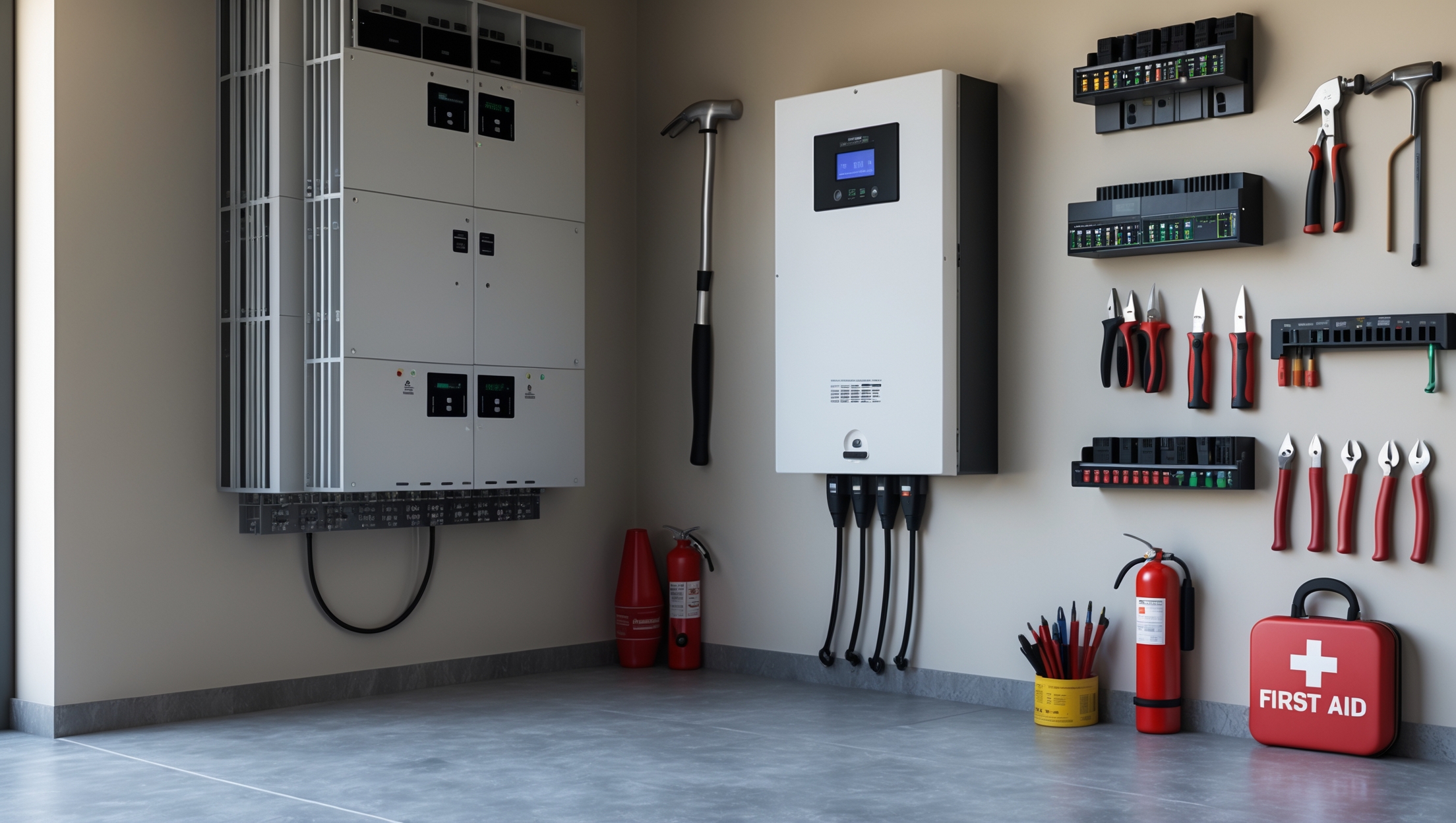Introduction: Why Safety Matters in Home Solar Battery Storage
As residential solar adoption continues to rise, more homeowners are seeking ways to store their renewable energy for use during the night or grid outages. Solar battery storage systems have emerged as a cornerstone technology for sustainable living and energy independence. However, while these batteries offer undeniable benefits, their installation is not without risks. Home battery systems store substantial amounts of electrical energy and, in many cases, use lithium-ion chemistry—posing unique fire, electrical, and chemical hazards if not properly handled. This comprehensive safety checklist is designed for homeowners, DIY enthusiasts, and professionals alike who are considering or planning the installation of a home solar battery storage system. By following rigorous safety protocols from planning through commissioning, you’ll not only safeguard your home and loved ones but also ensure that your green investment delivers reliable, efficient energy for years to come. Whether you’re adding batteries to an existing solar array or starting from scratch, this guide will walk you through the crucial steps to a safe, compliant installation.
Pre-Installation Safety Planning
1. Research Battery Technologies and Hazards
- Know Your Chemistry: Lithium-ion (LiFePO4, NMC), lead-acid (AGM, flooded), and saltwater batteries all have distinct safety profiles. Lithium-ion models, while popular for their energy density, require careful handling to avoid thermal runaway and fire.
- Understand Manufacturer Requirements: Read all technical manuals and safety datasheets (SDS) for your specific battery model before proceeding.
2. Assess Your Site for Safety and Compatibility
- Location Selection: Choose a cool, dry, and well-ventilated space, away from living areas, flammable materials, and direct sunlight. Garages, dedicated utility rooms, or outdoor weatherproof enclosures are ideal.
- Environmental Hazards: Avoid locations prone to flooding, excess humidity, or temperature extremes, which can degrade battery performance and safety.
- Structural Adequacy: Ensure walls or floors can support the weight of the battery bank and associated equipment.
3. Confirm Electrical System Readiness
- Panel Capacity: Verify your main electrical panel can handle the addition of the battery’s inverter and associated loads.
- Wiring: Assess the condition of existing wiring; upgrade as needed to meet ampacity and safety codes.
Personal Protective Equipment (PPE) Checklist
- Insulated gloves rated for electrical work
- Protective eyewear or face shield
- Flame-resistant clothing (especially for lithium-ion systems)
- Rubber-soled, non-conductive footwear
- Class ABC fire extinguisher (plus Class D for lithium-ion, if available)
- First-aid kit and emergency eye-wash station
Code Compliance and Permitting
1. Understand Local and National Codes
- National Electrical Code (NEC) Article 706: Governs energy storage systems in the United States.
- International Residential Code (IRC): May set fire separation and location requirements.
- Local Amendments: Always check with your municipal or county permitting office for additional restrictions.
2. Secure Required Permits
- Obtain electrical and building permits before beginning installation.
- Ensure all equipment has appropriate UL (or equivalent) safety certifications.
- Schedule inspections as required at rough-in and final stages.
Safe Handling and Transport of Batteries
- Inspect all batteries for physical damage before moving; do not use swollen, cracked, or leaking units.
- Transport batteries upright and secure them to prevent tipping.
- Never short-circuit terminals; use insulated covers or tape during handling.
- Store batteries in original packaging until installation to protect terminals.
Installation Safety Steps
1. Prepare the Mounting Area
- Clear the workspace of clutter and flammable materials.
- Install fire-rated backing boards if required by code or manufacturer.
- Ensure adequate spacing for air circulation per manufacturer’s spec (typically 6 inches minimum on all sides).
2. Electrical Isolation
- Shut off all relevant circuit breakers before starting any work.
- Confirm de-energization with a non-contact voltage tester.
- Post warning signage to prevent accidental energization during installation.
3. Secure Mounting
- Use only manufacturer-approved brackets or racks to mount wall or floor systems—never improvise.
- Anchor racks to studs or concrete, not drywall alone.
- Check for level and alignment to avoid mechanical stress on terminals and wiring.
4. Safe Electrical Connections
- Follow manufacturer torque specs for all lugs and fasteners.
- Use appropriately sized, insulated cables rated for DC voltage/amps.
- Install fused disconnects and/or circuit breakers within reach of the battery and inverter.
- Never connect or disconnect batteries under load; always ensure circuits are open.
- Use anti-oxidation compound on all terminals to reduce corrosion risks.
5. Grounding and Bonding
- Bond battery negative terminals to ground per code to prevent stray voltage and shock hazards.
- Connect system ground wire to the main electrical panel’s ground bus using appropriate gauge wire.
6. Fire Safety Measures
- Install smoke and heat detectors in the battery room or enclosure.
- Ensure clear access to fire extinguishers and emergency shutoff switches.
- For lithium-ion systems, consider installing automatic battery disconnects and temperature monitoring sensors.
Commissioning and Initial Testing
- Double-check all connections for proper torque and polarity before energizing.
- Power up the system incrementally, monitoring for abnormal noises, heat, or odors.
- Test all safety disconnects and alarms to confirm functionality.
- Verify communication with any monitoring software or mobile apps for real-time status updates.
- Record initial voltages, currents, and temperatures for future reference.
Post-Installation Safety Checks
- Ensure all covers and enclosures are securely fastened to prevent accidental contact.
- Label all circuits, disconnects, and battery banks per NEC requirements.
- Post emergency contact information and basic shutdown procedures nearby in clear view.
- Store maintenance and safety documentation in an accessible location for all household members.
Routine Safety Maintenance
1. Visual Inspections
- Check monthly for corrosion, swelling, or discoloration on terminals and battery casings.
- Inspect wiring for abrasion, overheating, or loose connections.
- Look for signs of pests or moisture inside the enclosure.
2. Electrical Testing
- Quarterly voltage and current checks to confirm batteries are charging and discharging within safe ranges.
- Test ground continuity and insulation resistance annually with appropriate meters.
3. Fire and Emergency Equipment
- Replace or recharge fire extinguishers as needed; check pressure gauges monthly.
- Test smoke and heat detectors semi-annually.
- Review and practice emergency shutdown procedures with all household members annually.
Safe Disposal and End-of-Life Considerations
- Do not dispose of batteries in household trash—use certified recycling centers.
- Follow manufacturer and local guidelines for safe decommissioning and removal.
- Transport spent batteries in non-conductive containers; never mix chemistries.
- Update emergency services with battery removal date and location if system is decommissioned.
Special Considerations for DIY vs. Professional Installation
While many homeowners are capable of installing solar arrays, battery storage systems involve higher voltages and complex safety protocols. Consider the following:
- DIY installation may void manufacturer warranties or insurance coverage if not performed by a licensed electrician.
- Some jurisdictions legally require professional installation for lithium-ion systems above certain capacities.
- Professional installers have access to specialized equipment for load testing and fault detection, reducing the risk of undetected hazards.
Conclusion: Safety Is the Foundation of Sustainable Energy
Adopting home solar battery storage is a powerful step toward energy independence and environmental stewardship—but only if executed with a rigorous commitment to safety. Each stage, from initial planning and permitting to hands-on installation and ongoing maintenance, presents unique risks that must be addressed with diligence and expertise. By following the safety checklist in this guide, you dramatically reduce the risk of fire, electrical shock, and other hazards that can jeopardize not only your home and investment but also your family’s well-being. Remember: safety is not a one-time action, but a continuous process that adapts with new technologies, evolving codes, and your system’s changing needs. When in doubt, consult with licensed professionals and never cut corners on equipment, PPE, or compliance. Through careful preparation and vigilant maintenance, your home battery storage system can provide years of secure, reliable, and green energy. With safety as your foundation, you’ll maximize your sustainable living goals while protecting what matters most.





I noticed the article mentions lithium-ion, lead-acid, and saltwater batteries with different safety profiles. Could you explain which type is typically considered safest for home use, especially in terms of fire risk and long-term reliability?
Of the battery types mentioned, saltwater batteries are generally considered the safest for home use, particularly because they are non-flammable and have no toxic heavy metals. Lithium-ion batteries are widely used due to their efficiency but can pose a higher fire risk if damaged or improperly installed. Lead-acid batteries are reliable and have a long track record, but they do contain corrosive materials. For fire safety and reliability, saltwater batteries stand out, though they are less common and may have lower energy density.